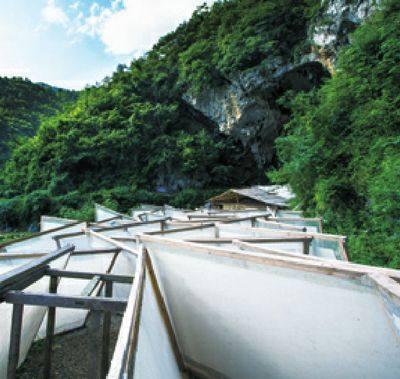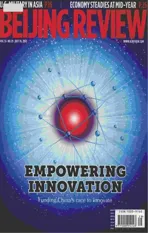The Papermakers
2012-04-29ByYuLintao
By Yu Lintao


Inside a typical cave amongst the karst scenery of the mountainous Shiqiao Village in Danzhai County, southwest Chinas Guizhou Province, an ancient trade is being restored. The Shiqiao Qianshan Ancient Papermaking Cooperative (SQAPC) is located in a small 400-square-meter cave, where organizers hold workshops teaching ancient papermaking techniques alongside the caves crystal spring water flow.
“One of the main reasons we chose the cave for our workshop is that the spring water here is rich, high-quality and unpolluted, which is a key factor for papermaking,” said Wang Xingwu, a villager of Shiqiao and Director of SQAPC.
Historic handicraft
Wangs workshop is not the only papermaking outfit in Shiqiao. Composed mostly of people from the Miao ethnic group, the village is well known for its ancient papermaking technique that dates back to the Tang Dynasty (618-907).
At present, there are about 300 households in the village and more than 1,200 people. Almost all the villagers, male and female, young and old, learn about papermaking.
The houses of Miao people are mostly built with logs on huge rock foundations. They are strong, simple, yet artistic structures. In Shiqiao, almost all houses are equipped with small papermaking workshops: a stone pool, wood-framed groove for making paper pulp and heated adobe platforms for drying paper.
Villagers said the ancient craft of papermaking in Shiqiao is different from modernday mechanized production. The raw material includes the bark of a special kind of tree and paper mulberry, which can be easily found in the local area. From collecting tree bark, to pulling off the dry paper from the baking wall, it involves 14 steps to produce a finished piece of paper. All the steps are operated by hand, with no industrial chemicals used during the whole process.
Wang, who was born in 1966, learned the village trade from his father in 1980. “My ancestors had been engaged in papermaking for more than 1,000 years. I am the 19th generation of my family to inherit the skill,” Wang said to Beijing Review.
However, the industrialization of China and the advent of modern technology have had a huge impact on the traditional papermaking business. With the changing demand of consumers, the number of villagers who can subsist through the trade has declined in recent years. The ancient craft is in danger of extinction.
In 1998, when Fu Yingchun, Director General of Tourism Administration of Guizhou Province (TAG) went to Danzhai in search of ideal tourist locations, he was introduced to the papermaking tradition in Shiqiao. Fu considered the papermaking craft a living fossil of ancient Chinese civilization, of value to both culture and tourism alike. Since then, the craft has undergone a revival. Shiqiao became a popular destination for tourists with an interest in ancient artistic practices.
“It was Fu who helped preserve and develop the ancient craft, saving it from ultimate extinction,” said Wang.
A second chance
The papermaking business in Shiqiao saw a chance for renewed development. Wang, the master craftsman, first broke with the tradition of making bast paper exclusively and began developing new products. He invented a kind of colorful paper made of local wildflowers. In 2000, a Hong Kong businessman showed great interest in his products and purchased 60,000 pieces of paper in one order for 3 yuan($0.4) per sheet.
After the initial success, Wang developed two more important paper products: Gui paper and Yingchun paper in 2006 and 2008, respectively.
Wang said Gui paper is used for art painting, and is on par with the famous Chinese rice paper.
“Compared with the rice paper, Gui paper has its own unique features. As it is a kind of handmade product without any chemical materials, it is rougher than the rice paper and allows ink to disperse naturally on the paper, creating a unique effect. Many paint-ers from China Central Academy of Fine Arts (CCAFA), Guizhou Painting, Shanghai Painting as well as Guangzhou Painting academies prefer to use Gui paper,” said Wang.
“Gui paper has a kind of rough texture and unadorned beauty,” said Hu Shipeng, a well-known painter in Guiyang, capital of Guizhou Province.
In addition, Wang said, because its fiber is much longer, Gui paper is much more pliable than the rice paper. “When you pull out a sheet of Gui paper from water, it can be painted on directly and will not break,” said Wang.
Yingchun paper is named after Fu of TAG for his contribution to the preservation of Shiqiao papermaking techniques.
Yingchun paper is mainly used for restoration of ancient books. “Paper used to restore ancient books must be mildly alkaline with a potential of hydrogen value between seven and eight,” Wang explained. With the help of restoration experts such as Professor Yue Qianshan of CCAFA and Xu Heng of Guizhou University, Wang developed handmade replicas of ancient paper.
“Experts estimate that Yingchun paper can be kept for about 1,500 years, making it a good fit for book restoration projects,” Wang said.
Wang said the paper is of such high quality because the entire process, from raw materials to the construction, is totally natural and pollution-free. “The waste from our papermaking can be used for crop field ir- rigation,” said Wang. “In addition, Yingchun paper is handmade, which means the fibers of the material are not damaged during the process.”
Mechanized paper production takes only a few days, but from collecting material to drying the paper, Shiqiao papermaking requires about 45 days. “The Shiqiao method is very detailed and complicated. That is why our product is unique,” said Wang.
When foreign travelers first saw the ancient papermaking technique, they were impressed with the careful attention to detail, and some placed orders for the paper. According to Wang, his products have been exported to Australia, the United States, France, Japan and other countries. A French businessman has also signed a long-term cooperation agreement with him.
In recent years, as Shiqiao paper has been exported to foreign countries, many foreign visitors have arrived to the village for tours.
In 2006, Shiqiao papermaking was inscribed on the state-level cultural heritage protection list. Later, Wang was honored as bearer of the ancient technique.
More investment needed
In 2008, altogether 61 families in Shiqiao headed by Wang established the SQAPC, aiming for large-scale operation and expanded development.
Currently, a total of 66 workers are em- ployed in the SQAPC with an average annual output of about 100,000 sheets of paper.
“We still lack funds, so we dont have a large plant and drying equipment. We rely on the sunshine to dry the paper, so during rainy or winter weather, we cannot work,” Wang said. “Though we have excellent technique and big market, we dont have the money to buy drying equipment to expand production.”
Wang said his product is now popular both domestically and in some overseas markets. The annual demand for Yingchun paper from the National Library of China, for example, is more than 10 million sheets, but his workshop can only provide a small fraction of the total demand.
Wang hopes some businesspeople could cooperate with the project and invest in his company.
“If we get enough investment to build a new plant to expand our business, we can greatly increase our efficiency and output,”Wang said.
At present, Wang has six young men working as his apprentices. He hopes they could become successors of the craft and carry forward Shiqiaos papermaking business. “My dream is to make the best paper in the world,” Wang said.
